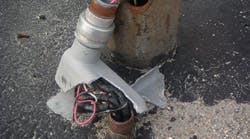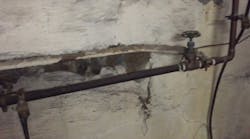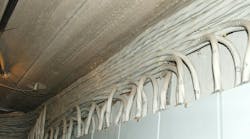As usual, never consider the following commentary associated with these photos as a formal interpretation of the National Electrical Code (NEC). Without criticizing anyone or any product, the following scenarios present us with serious safety questions.
INTERESTING HAND HOLE
This installation is located in the parking lot of a commercial office building. The photo was taken at the base of a 30-ft pole used to support luminaires. Metal poles of this height may be used to support luminaires and can serve as a raceway to enclose supply conductors. However, they must be equipped with both a hand hole not less than 2 in.×4 in. in size and a rain tight cover. The hand hole is meant to provide access to the supply terminations within the pole or pole base. When araceway riser or cable isn't installed within the pole, a threaded fitting or nipple must be brazed or welded to the pole opposite the hand hole for the supply connection. The metal pole must also be provided with a grounding terminal, accessible from the hand hole. See Part IV. Luminaire (Fixture) Supports, 410.15(B).
ATTIC ANTICS
This makeshift wooden box certainly doesn't resemble a listed cabinet or enclosure per the NEC (Art. 100). The NEC defines a cabinet as “an enclosure that is designed for either surface mounting or flush mounting and is provided with a frame, mat, or trim in which a swinging door or doors are or can be hung.” It defines a panelboard as “a single panel or group of panel units designed for assembly in the form of a single panel, including buses and automatic overcurrent devices, and equipped with or without switches for the control of light, heat, or power circuits; designed to be placed in a cabinet or cutout box placed in or against a wall, partition, or other support; and accessible only from the front.”
Per 408.20, metal panelboard cabinets and panelboard frames must be touching each other and must be grounded. Where a panelboard is used with nonmetallic raceways or cable assemblies, or where separate grounding conductors are provided, a terminal bar for the grounding conductors must be secured inside of the cabinet. It must be bonded to the metal cabinet and panelboard frame or connected to the grounding conductor that runs with the conductors feeding the panelboard.
JAM PACKED
Besides missing a cover, this conduit body provides us with a good example of the intent of the rule noted in Chapter 9, Table 1, Percent of Cross Section of Conduit and Tubing for Conductors, FPN No. 2. The requirement states, “When pulling three conductors or cables into a raceway, if the ratio of the raceway (inside diameter) to the conductor or cable (outside diameter) is between 2.8 and 3.2, jamming can occur. While jamming can occur when pulling four or more conductors or cables into a raceway, the probability is very low.”
The reader who submitted this photo wants to know the same thing you probably do: How did this get past the building inspector? The electric utility plans on removing the conductors and “topping” the pole at a later date, but since there's no access to the base of the pole, the builder will be stuck pulling the pole butt.
Found a Code violation? Send your photos to Joe Tedesco at 350 North St., Boston, MA 02113 or [email protected].








